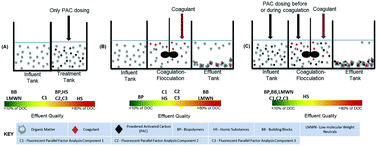Characterisation of dissolved organic matter to optimise powdered activated carbon and clarification removal efficiency†
Abstract
The character of dissolved organic matter (DOM) present in drinking water treatment systems greatly impacts its treatability by coagulation–flocculation. Powdered activated carbon dosing has been suggested to enhance DOM removal when combined with coagulation–flocculation. However, optimising powdered activated carbon (PAC) dosing requires further research. In this study, fluorescence spectroscopy combined with parallel factor analysis (PARAFAC) and liquid chromatography with organic carbon detection (LC–OCD) has been used to characterise DOM removal in three ways: (a) coagulation–flocculation–sedimentation without PAC dosing, (b) PAC dosing prior to- and (c) PAC dosing during coagulation–flocculation–sedimentation treatment. It was shown that only coagulation–flocculation–sedimentation preferentially removed biopolymer and humic substance chromatographic fractions and fluorescent DOM, whereas dosing PAC preferentially removed building blocks and low molecular weight neutral chromatographic fractions. The DOM treatability that was achieved when PAC was dosed both prior to- and during coagulation–flocculation–sedimentation was comparable, but higher than what was achieved without any PAC dosing. Introduction of PAC to the coagulation–flocculation–sedimentation process significantly improved DOM removal, with fluorescent components removed by 97%. This study also highlights that a combination of fluorescence spectroscopy and LC–OCD is essential to track the removal of both, fluorescent and non-fluorescent DOM fractions and understand their impacts on DOM treatability when using different treatment processes. Overall, lower residual DOM concentrations were obtained in the treated water when PAC adsorption and the coagulation–flocculation–sedimentation processes were combined when compared to treating the water with only one of the processes, despite differences in source water character of DOM.



 Please wait while we load your content...
Please wait while we load your content...